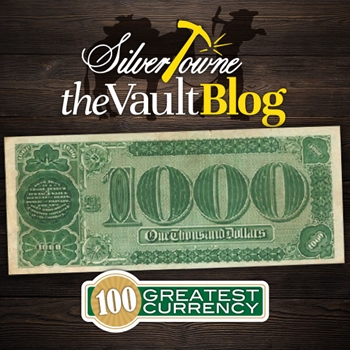
If you have followed along with this series since the beginning, you know that we do not really fancy any particular order as to how we present these breakdowns of Whitman Publishing’s 100 Greatest American Currency Notes. That brings us to today’s entry that unveils the #1 pick of the 100 total as put together by authors Q. David Bowers and David M. Sundman. One of a kind, uniquely named, and never forgotten, this note is still highly regarded as the Holy Grail for collectors.
#1 – A Legendary Rarity $1,000 “Grand Watermelon Note,” Series of 1890
Also known as the 1890 Coin Note or Treasury Note, the $1,000 “Grand Watermelon Note” got its name from the large, green zeroes on the back that resemble watermelons. Although the term and nickname are now deemed likable, in 1890 it was not viewed as such by the Treasury Department. In fact, actions were taken to change the design. The public also did not appreciate ornate designs such as this note at the time. The Treasury’s qualm with the notes suggested that the crowded design was much easier to counterfeit.
The 1890 Grand Watermelon notes had two different printings, one of which was the Rosecrans-Huston signature combination (F-379a). There were 16,000 of those printed, however, only five examples are known to exist today. The other is the Rosecrans-Nebeker red seal variety to which 12,000 were printed. Only two have been reported. A grand total of just seven notes are known to exist in the series 1890 $1,000 Watermelon Note, four of which belong to the government.
General George G. Meade is on the face of the note. This choice of figure was representative of the Treasury’s continued efforts to depict American Civil War heroes on all the current of the late 19th century. Born in Spain to American parents, he worked his way up through the ranks, attaining major general statue during the Civil War. His grandest accomplishment was winning the Battle of Gettysburg in 1863 which would prevent Confederate forces from continuing forward north into the Union.
In 1960, the historic market value of this note in a Choice About Uncirculated condition was $10,000. By this publication (2006), it rose to $1,250,000.







